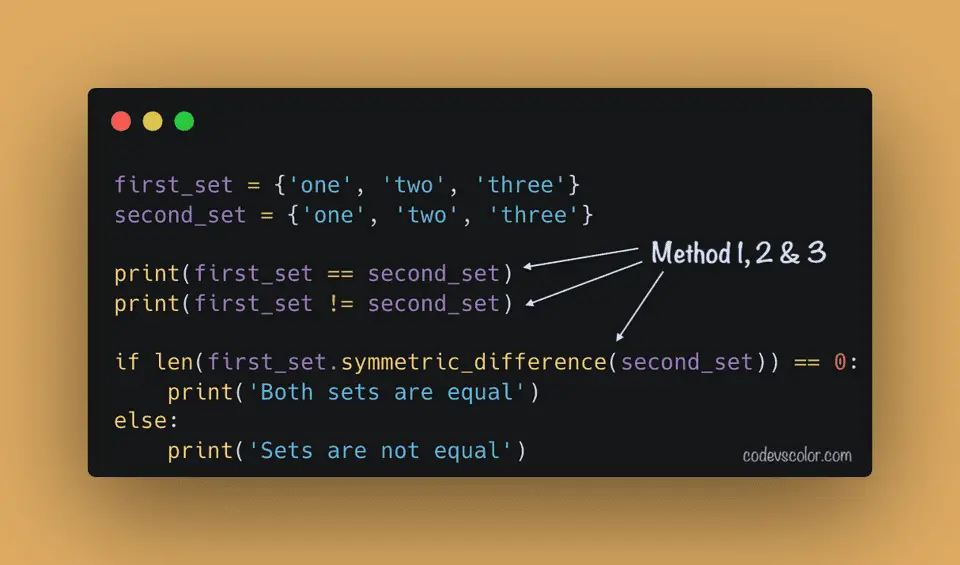Python program to check if two sets are equal:
Python set is an inbuilt data type and it is used to store collection of data. set doesn’t allow any duplicate elements and its items are unordered and un-indexed. If two sets have the same elements(in any order), these are considered equal.
This post will show you how to check if two sets are equal or not. We will learn two different ways to do that.
Method 1: By using the == operator:
We can check if two sets are equal or not by using the == operator. It will check if two sets are equal or not and return one boolean value. It returns True if the elements of the sets are equal. Else, it returns False. The order of the elements in the set is not considered for the comparison.
For example:
first_set = {'one', 'two', 'three'}
second_set = {'one', 'two', 'three'}
print(first_set == second_set)It will print:
TrueSimilarly, if we have different elements in the sets:
first_set = {'one', 'two', 'three'}
second_set = {'one', 'two', 'three', 'four'}
print(first_set == second_set)It will print:
FalseFor the following example:
first_set = {'one', 'two', 'three', 'one'}
second_set = {'one', 'two', 'three'}
print(first_set == second_set)It will print True because we can’t have duplicate items in a set. So, the set {'one', 'two', 'three', 'one'} is equal to {'one', 'two', 'three'}.
Download the program on Github
Method 2: By using != operator:
The operator != or not equal to can be used to check if one set is not equal to another set. It will return True if the sets are not equal and False otherwise. Let’s try it with an example:
first_set = {'one', 'two', 'three', 'one'}
second_set = {'one', 'two', 'three'}
third_set = {'one', 'two', 'three', 'four'}
print(first_set != second_set)
print(first_set != third_set)Download the program on Github
It will print False for the first one and True for the second one.
Method 3: By using the symmetric_difference() method:
We can also use the symmetric_difference method to find the difference between two sets. The symmetric_difference method is defined as below:
set1.symmetric_difference(set2)The summetric_difference() method returns one set with zero elements if both hold similar elements. Otherwise, it will return the elements which are not common in the sets. We can check the length of the returned set to find if both are equal or not. The len() method can be used to check the length of the returned set. The return value of this method will be 0 if the sets are equal.
Below is the complete program:
first_set = {'one', 'two', 'three'}
second_set = {'one', 'two', 'three', 'one'}
if len(first_set.symmetric_difference(second_set)) == 0:
print('Both sets are equal')
else:
print('Sets are not equal')Download the program on Github
If you run this program, it will print the below output:
Both sets are equalCan we use the difference() method to check if two sets are equal or not?
We can’t use the difference() method to check for set equality. The syntax of the difference method is:
set1.difference(set2)It will return the elements that are in set1 but not in set2. If the set1 is a subset of set2, it will return an empty set. e.g.
first_set = {'one', 'two', 'three'}
second_set = {'one', 'two', 'three', 'four'}
if len(first_set.difference(second_set)) == 0:
print('Both sets are equal')
else:
print('Sets are not equal')Even though the sets first_set and second_set are not equal, it will print those as equal.
Both sets are equalYou might also like:
- Python program to check if a subarray is in an array
- How to calculate gross pay for hourly paid employees in Python
- Python program to find the volume of a tetrahedron
- Python program to search for a text in a file
- How to insert an item to the start of an Ordered dictionary in Python
- How to write a simple stopwatch in python

